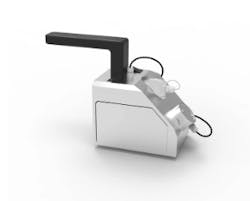Measures Diffuse & Specular Surface Reflectance In Situ
The LCR-20 is designed to measure UV reflection of surfaces in the UVC spectral range. 45° and 0° measurement geometry settings are possible.
The battery operated LCR-20 employs a collimated UVC LED based source with a reference detector to monitor and correct UV output fluctuations and a UV-37xx detector that connects to a customized X1 meter for readout of reflectance values.
Recalibration in the field is possible using an ODM reference standard for calibration at 45°/0° (diffuse reflectance), For 45°/45° (specular reflectance) a UV-enhanced mirror can be supplied optionally.
The International Ultraviolet Association recently announced the LCR-20 has earned its UV Product Innovation award for 2021. The IUVA awards recognize achievement in UV innovative technology.
The LCR-20 is a unique and much needed tool for use in UVC disinfection applications. It provides a means to measure UVC surface reflectance, both specular and diffuse, on site. This information is needed for accurate modeling of expected UVGI (ultraviolet germicidal irradiation) levels within a space.
Gigahertz-OptikGmbH which has been in business since 1986 and joined the Berghof Group in 2020, specializes in the development, production, calibration and distribution of optical radiation measurement equipment with expertise in the entire optical spectral range from ultraviolet (UV) to infrared (IR). The company has a reputation for taking on custom projects, the results of which often become part of its wide range of standard products that includes a variety of light measurement products for optical radiation, as well as materials and coatings, light sources and accessories.
In describing the genesis of the LCR-20 UV Reflectance Meter, Bob Angelo, managing director for Gigahertz-Optik Inc., the company's subsidiary in the US, explained that a leading UV light source manufacturer approached the company with a request to design a field portable UVC surface reflectance meter. The need for this type of tool was shared by Gigahertz-Optik company clients that were involved in the software modeling of upper room UVGI surface reflectance values.The LCR-20 system components include the Gigahertz-Optik UV-3725 detector head sensor which attaches to the LCR-20, a UV LED collimated light source that, in turn, connects to its X1-5 Optometer to control the devices and display operational and measurement data.
"The LCR-20 is the only currently available UVC reflectance meter that can measure surfaces in situ," said Angelo. "Until now, samples of the surface material needed to be taken to the lab and measured on a floor-based spectrophotometer. Typically, a small sample of surface material needed to be cut to fit into the sample chamber of the spectrophotometer." The ability to take the meter to the site of the surfaces is a huge improvement over having to extract a portion of all relevant surfaces to take to the meter in a lab.
To create a meter suitable for use on different types of walls, counters and ceiling surfaces, Gigahertz-Optik engineered and fine tuned the meter's requirements for spectra, operation, measurement geometry (45 degree/0 degree for diffuse reflectance and 45 degree/45/degree for specular reflectance), measurement uncertainty and reference standards. Future versions of the meter will include an expansion of its spectral capability beyond 254nm.Angelo described a scenario in which the LCR-20, UV-3725 and X1-5 can be used. "UVC fixtures employing low pressure Hg lamps are being installed in a hospital ward. The UVC output is to be mapped using modeling software to ensure there is sufficient UVGI being delivered as uniformly as possible across the upper room, and UV health hazard risks also must be assessed to ensure occupant safety."
So to complete the computer modeling the UV germicidal irradiance and UV hazard risk need to be measured as well as the UV reflectance. This can be accomplished by adding an extra UV-3725 detector for use with the X1-5 meter. A UVGI survey kit is available to complete all of these measurement requirements.
